Analyzing the Impact of Healthcare Networking on Service Provision
VerifiedAdded on 2023/06/07
|7
|1791
|392
Report
AI Summary
This report investigates the impact of healthcare networking among professionals on healthcare provision. It identifies various platforms used for networking, including social media, professional networking sites, and conferences, highlighting their role in sharing experiences and insights. The study outlines the benefits of networking, such as evidence-informed decision-making, access to new ideas and research findings, and enhanced patient understanding. It also addresses potential dangers like misinformation, breaches of confidentiality, and over-reliance on specific individuals or groups. The report concludes that effective networking requires careful management, data sharing, and collaboration to improve healthcare delivery and outcomes, emphasizing the importance of continuous learning and adaptation within the healthcare profession.
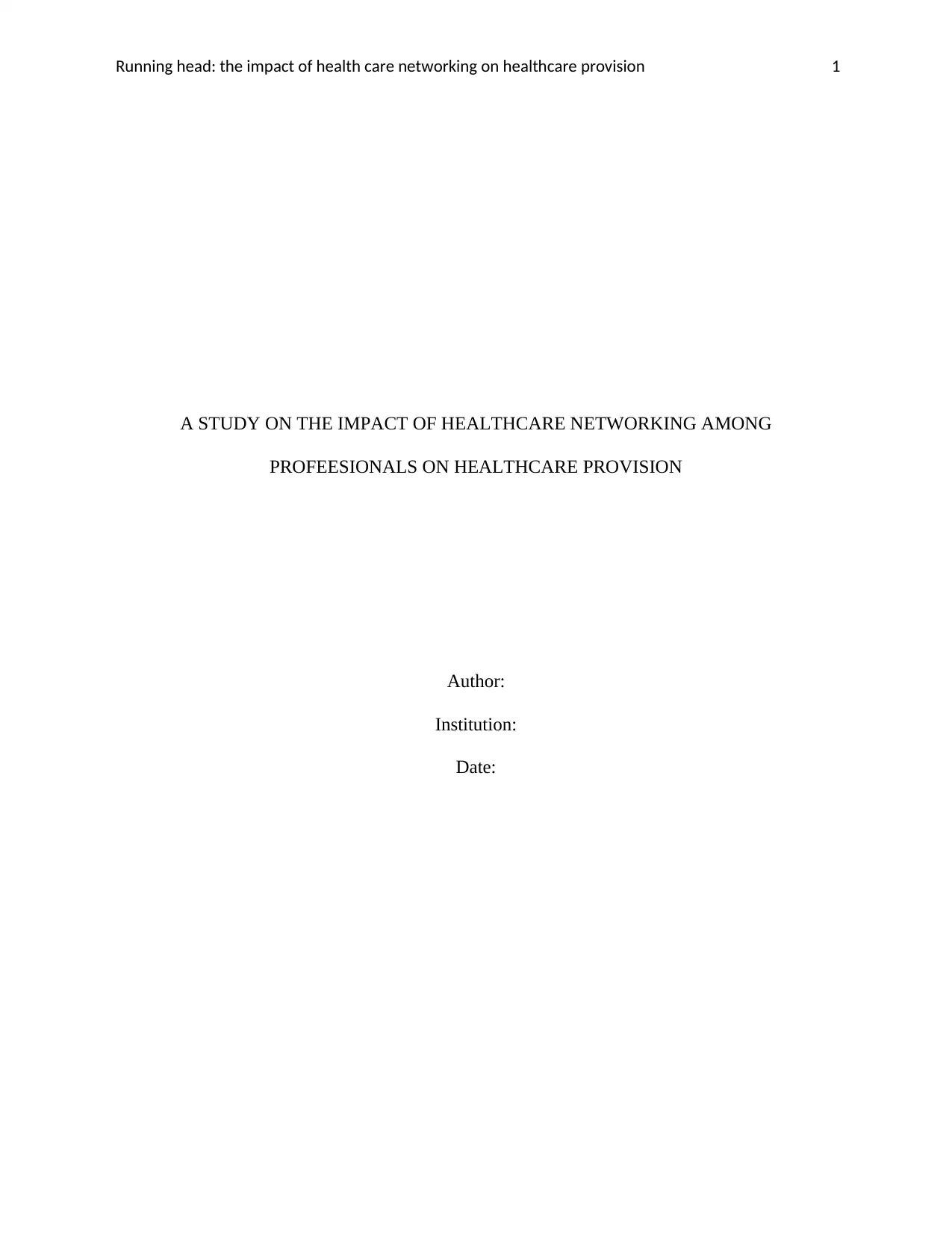
Running head: the impact of health care networking on healthcare provision 1
A STUDY ON THE IMPACT OF HEALTHCARE NETWORKING AMONG
PROFEESIONALS ON HEALTHCARE PROVISION
Author:
Institution:
Date:
A STUDY ON THE IMPACT OF HEALTHCARE NETWORKING AMONG
PROFEESIONALS ON HEALTHCARE PROVISION
Author:
Institution:
Date:
Paraphrase This Document
Need a fresh take? Get an instant paraphrase of this document with our AI Paraphraser
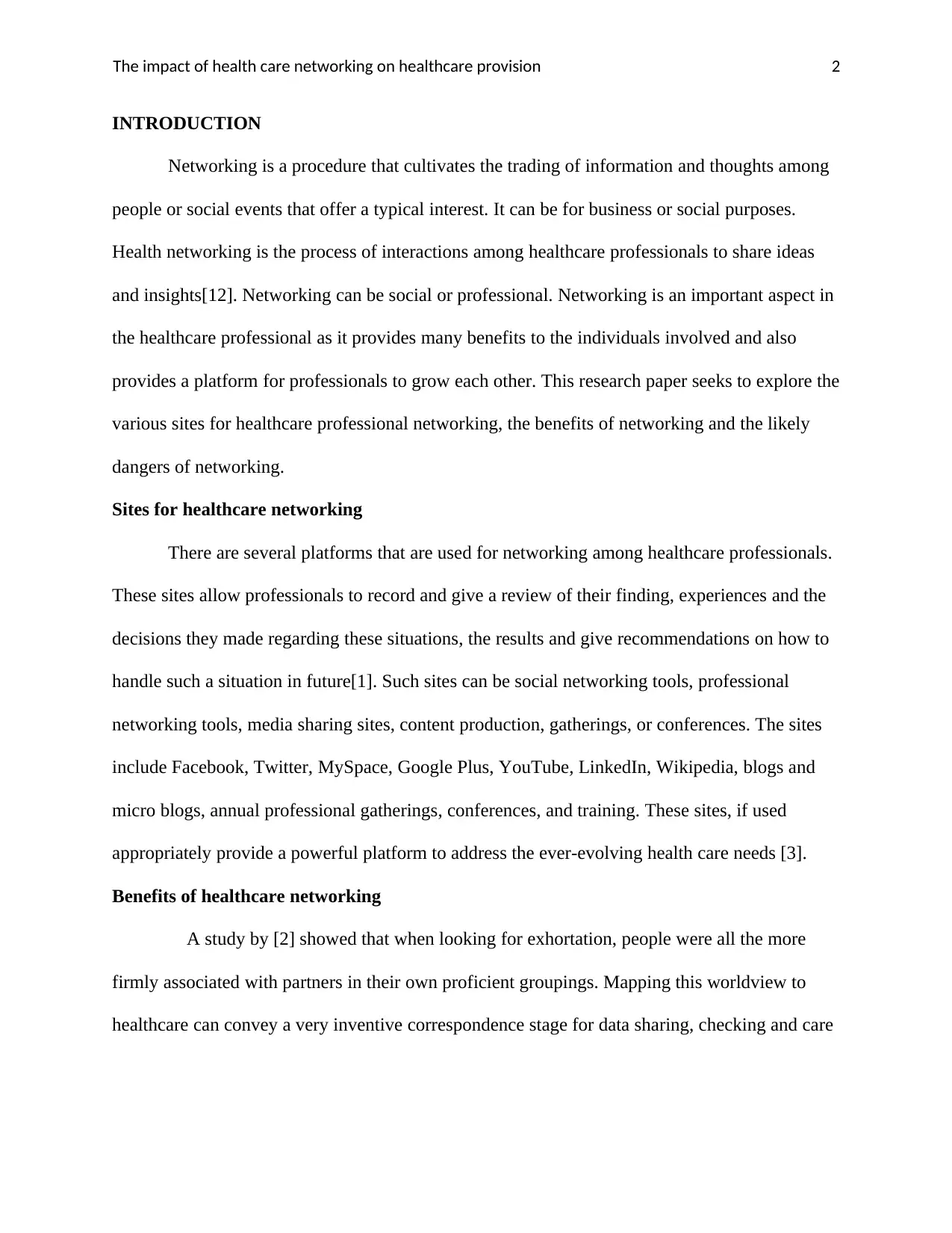
The impact of health care networking on healthcare provision 2
INTRODUCTION
Networking is a procedure that cultivates the trading of information and thoughts among
people or social events that offer a typical interest. It can be for business or social purposes.
Health networking is the process of interactions among healthcare professionals to share ideas
and insights[12]. Networking can be social or professional. Networking is an important aspect in
the healthcare professional as it provides many benefits to the individuals involved and also
provides a platform for professionals to grow each other. This research paper seeks to explore the
various sites for healthcare professional networking, the benefits of networking and the likely
dangers of networking.
Sites for healthcare networking
There are several platforms that are used for networking among healthcare professionals.
These sites allow professionals to record and give a review of their finding, experiences and the
decisions they made regarding these situations, the results and give recommendations on how to
handle such a situation in future[1]. Such sites can be social networking tools, professional
networking tools, media sharing sites, content production, gatherings, or conferences. The sites
include Facebook, Twitter, MySpace, Google Plus, YouTube, LinkedIn, Wikipedia, blogs and
micro blogs, annual professional gatherings, conferences, and training. These sites, if used
appropriately provide a powerful platform to address the ever-evolving health care needs [3].
Benefits of healthcare networking
A study by [2] showed that when looking for exhortation, people were all the more
firmly associated with partners in their own proficient groupings. Mapping this worldview to
healthcare can convey a very inventive correspondence stage for data sharing, checking and care
INTRODUCTION
Networking is a procedure that cultivates the trading of information and thoughts among
people or social events that offer a typical interest. It can be for business or social purposes.
Health networking is the process of interactions among healthcare professionals to share ideas
and insights[12]. Networking can be social or professional. Networking is an important aspect in
the healthcare professional as it provides many benefits to the individuals involved and also
provides a platform for professionals to grow each other. This research paper seeks to explore the
various sites for healthcare professional networking, the benefits of networking and the likely
dangers of networking.
Sites for healthcare networking
There are several platforms that are used for networking among healthcare professionals.
These sites allow professionals to record and give a review of their finding, experiences and the
decisions they made regarding these situations, the results and give recommendations on how to
handle such a situation in future[1]. Such sites can be social networking tools, professional
networking tools, media sharing sites, content production, gatherings, or conferences. The sites
include Facebook, Twitter, MySpace, Google Plus, YouTube, LinkedIn, Wikipedia, blogs and
micro blogs, annual professional gatherings, conferences, and training. These sites, if used
appropriately provide a powerful platform to address the ever-evolving health care needs [3].
Benefits of healthcare networking
A study by [2] showed that when looking for exhortation, people were all the more
firmly associated with partners in their own proficient groupings. Mapping this worldview to
healthcare can convey a very inventive correspondence stage for data sharing, checking and care
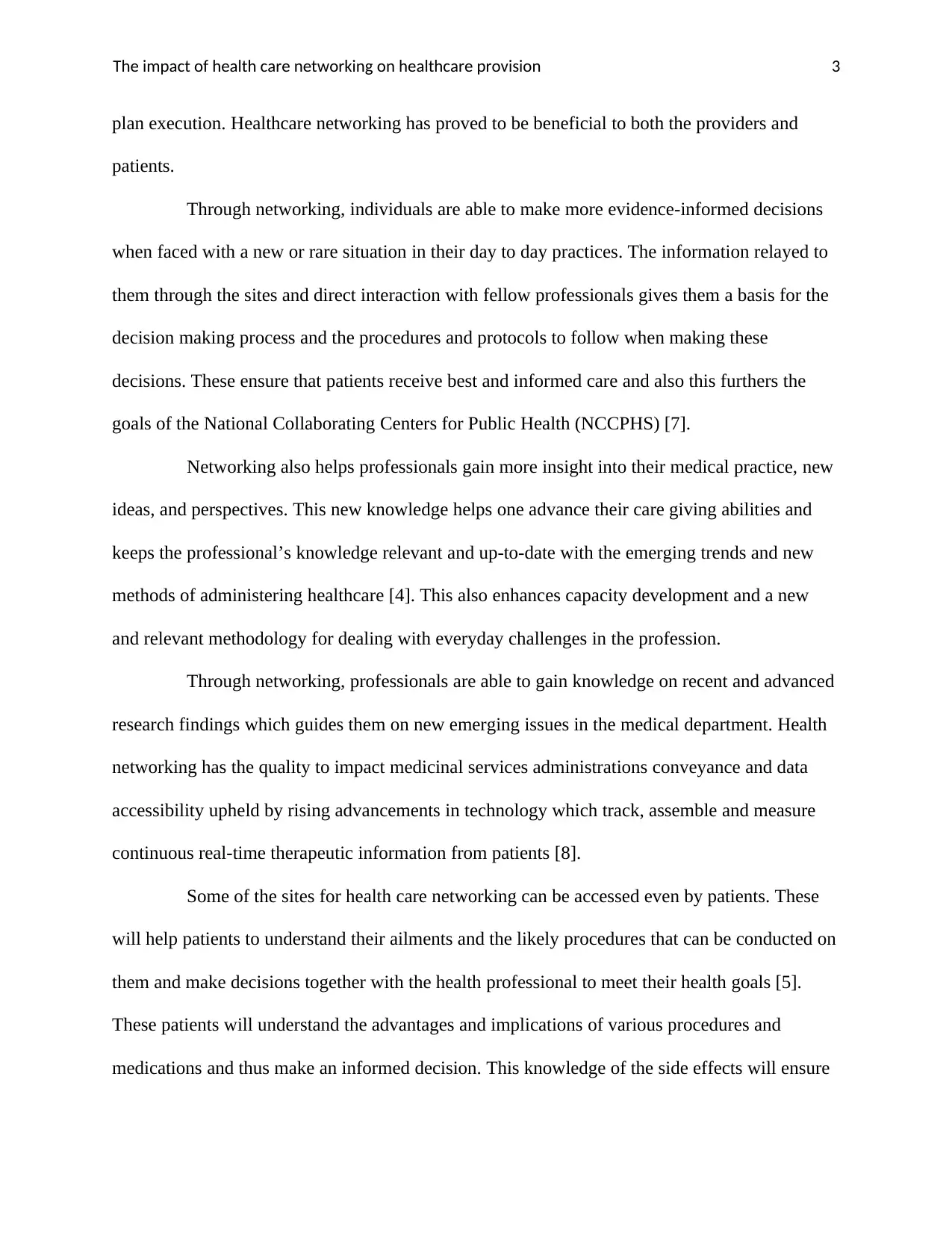
The impact of health care networking on healthcare provision 3
plan execution. Healthcare networking has proved to be beneficial to both the providers and
patients.
Through networking, individuals are able to make more evidence-informed decisions
when faced with a new or rare situation in their day to day practices. The information relayed to
them through the sites and direct interaction with fellow professionals gives them a basis for the
decision making process and the procedures and protocols to follow when making these
decisions. These ensure that patients receive best and informed care and also this furthers the
goals of the National Collaborating Centers for Public Health (NCCPHS) [7].
Networking also helps professionals gain more insight into their medical practice, new
ideas, and perspectives. This new knowledge helps one advance their care giving abilities and
keeps the professional’s knowledge relevant and up-to-date with the emerging trends and new
methods of administering healthcare [4]. This also enhances capacity development and a new
and relevant methodology for dealing with everyday challenges in the profession.
Through networking, professionals are able to gain knowledge on recent and advanced
research findings which guides them on new emerging issues in the medical department. Health
networking has the quality to impact medicinal services administrations conveyance and data
accessibility upheld by rising advancements in technology which track, assemble and measure
continuous real-time therapeutic information from patients [8].
Some of the sites for health care networking can be accessed even by patients. These
will help patients to understand their ailments and the likely procedures that can be conducted on
them and make decisions together with the health professional to meet their health goals [5].
These patients will understand the advantages and implications of various procedures and
medications and thus make an informed decision. This knowledge of the side effects will ensure
plan execution. Healthcare networking has proved to be beneficial to both the providers and
patients.
Through networking, individuals are able to make more evidence-informed decisions
when faced with a new or rare situation in their day to day practices. The information relayed to
them through the sites and direct interaction with fellow professionals gives them a basis for the
decision making process and the procedures and protocols to follow when making these
decisions. These ensure that patients receive best and informed care and also this furthers the
goals of the National Collaborating Centers for Public Health (NCCPHS) [7].
Networking also helps professionals gain more insight into their medical practice, new
ideas, and perspectives. This new knowledge helps one advance their care giving abilities and
keeps the professional’s knowledge relevant and up-to-date with the emerging trends and new
methods of administering healthcare [4]. This also enhances capacity development and a new
and relevant methodology for dealing with everyday challenges in the profession.
Through networking, professionals are able to gain knowledge on recent and advanced
research findings which guides them on new emerging issues in the medical department. Health
networking has the quality to impact medicinal services administrations conveyance and data
accessibility upheld by rising advancements in technology which track, assemble and measure
continuous real-time therapeutic information from patients [8].
Some of the sites for health care networking can be accessed even by patients. These
will help patients to understand their ailments and the likely procedures that can be conducted on
them and make decisions together with the health professional to meet their health goals [5].
These patients will understand the advantages and implications of various procedures and
medications and thus make an informed decision. This knowledge of the side effects will ensure
⊘ This is a preview!⊘
Do you want full access?
Subscribe today to unlock all pages.

Trusted by 1+ million students worldwide
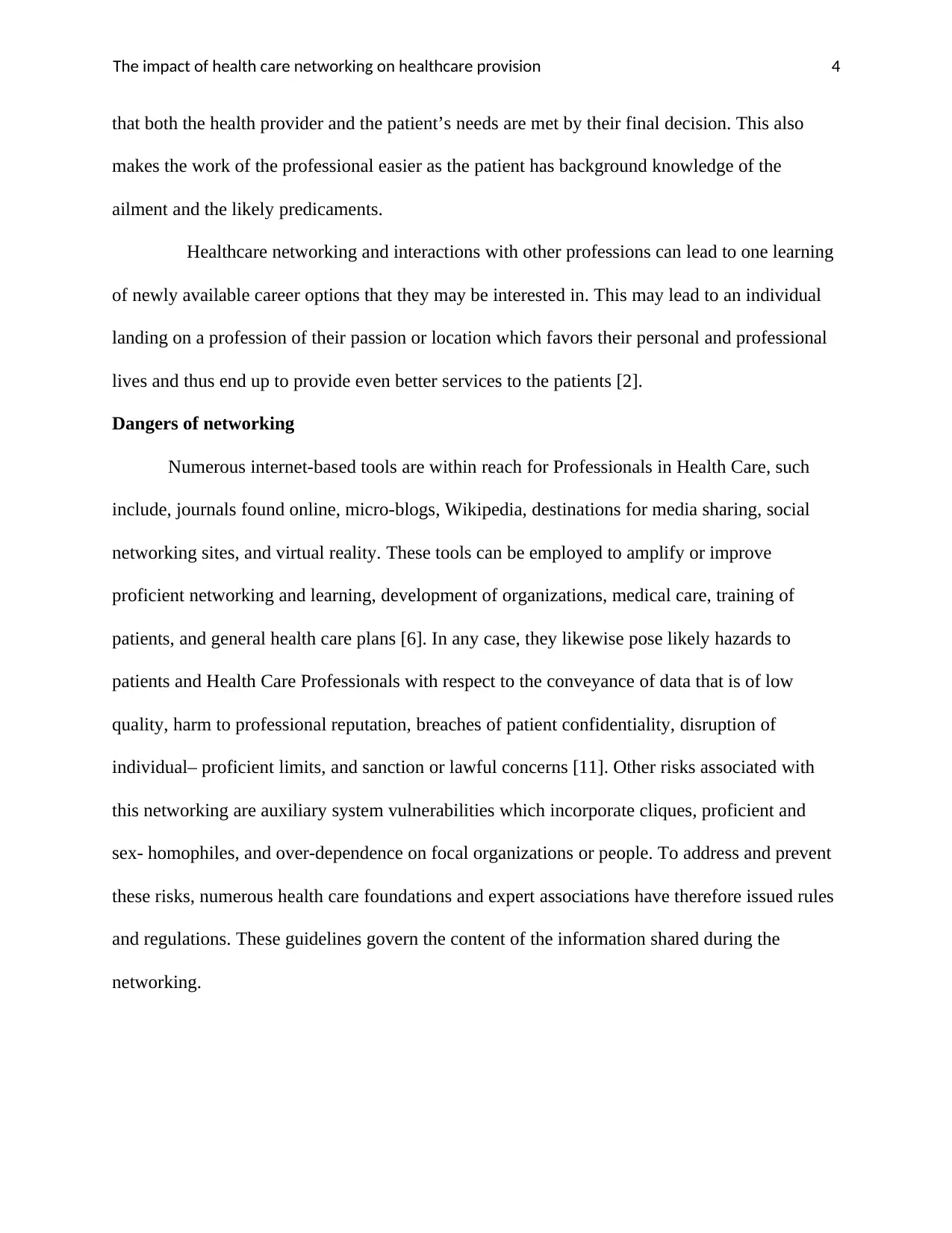
The impact of health care networking on healthcare provision 4
that both the health provider and the patient’s needs are met by their final decision. This also
makes the work of the professional easier as the patient has background knowledge of the
ailment and the likely predicaments.
Healthcare networking and interactions with other professions can lead to one learning
of newly available career options that they may be interested in. This may lead to an individual
landing on a profession of their passion or location which favors their personal and professional
lives and thus end up to provide even better services to the patients [2].
Dangers of networking
Numerous internet-based tools are within reach for Professionals in Health Care, such
include, journals found online, micro-blogs, Wikipedia, destinations for media sharing, social
networking sites, and virtual reality. These tools can be employed to amplify or improve
proficient networking and learning, development of organizations, medical care, training of
patients, and general health care plans [6]. In any case, they likewise pose likely hazards to
patients and Health Care Professionals with respect to the conveyance of data that is of low
quality, harm to professional reputation, breaches of patient confidentiality, disruption of
individual– proficient limits, and sanction or lawful concerns [11]. Other risks associated with
this networking are auxiliary system vulnerabilities which incorporate cliques, proficient and
sex- homophiles, and over-dependence on focal organizations or people. To address and prevent
these risks, numerous health care foundations and expert associations have therefore issued rules
and regulations. These guidelines govern the content of the information shared during the
networking.
that both the health provider and the patient’s needs are met by their final decision. This also
makes the work of the professional easier as the patient has background knowledge of the
ailment and the likely predicaments.
Healthcare networking and interactions with other professions can lead to one learning
of newly available career options that they may be interested in. This may lead to an individual
landing on a profession of their passion or location which favors their personal and professional
lives and thus end up to provide even better services to the patients [2].
Dangers of networking
Numerous internet-based tools are within reach for Professionals in Health Care, such
include, journals found online, micro-blogs, Wikipedia, destinations for media sharing, social
networking sites, and virtual reality. These tools can be employed to amplify or improve
proficient networking and learning, development of organizations, medical care, training of
patients, and general health care plans [6]. In any case, they likewise pose likely hazards to
patients and Health Care Professionals with respect to the conveyance of data that is of low
quality, harm to professional reputation, breaches of patient confidentiality, disruption of
individual– proficient limits, and sanction or lawful concerns [11]. Other risks associated with
this networking are auxiliary system vulnerabilities which incorporate cliques, proficient and
sex- homophiles, and over-dependence on focal organizations or people. To address and prevent
these risks, numerous health care foundations and expert associations have therefore issued rules
and regulations. These guidelines govern the content of the information shared during the
networking.
Paraphrase This Document
Need a fresh take? Get an instant paraphrase of this document with our AI Paraphraser
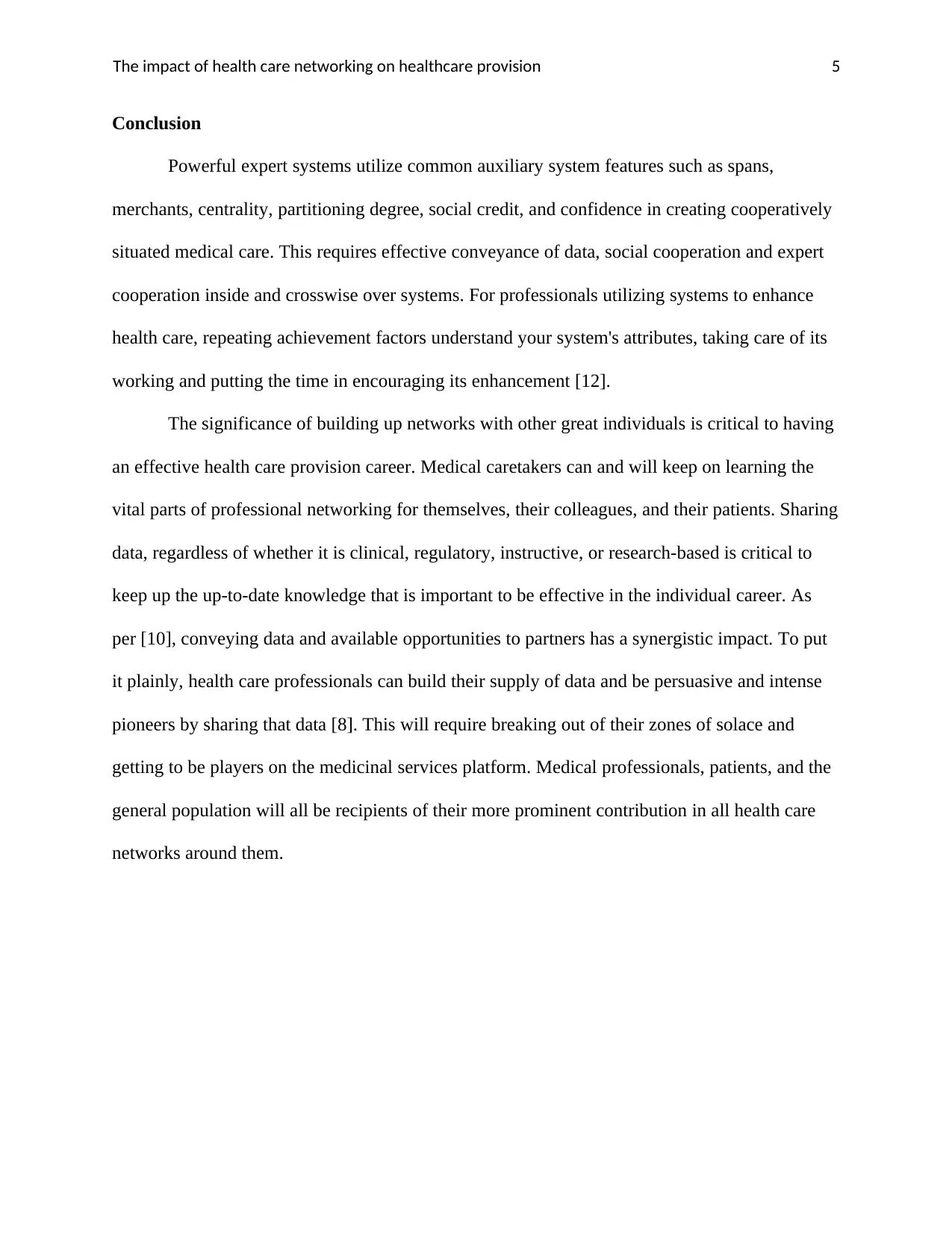
The impact of health care networking on healthcare provision 5
Conclusion
Powerful expert systems utilize common auxiliary system features such as spans,
merchants, centrality, partitioning degree, social credit, and confidence in creating cooperatively
situated medical care. This requires effective conveyance of data, social cooperation and expert
cooperation inside and crosswise over systems. For professionals utilizing systems to enhance
health care, repeating achievement factors understand your system's attributes, taking care of its
working and putting the time in encouraging its enhancement [12].
The significance of building up networks with other great individuals is critical to having
an effective health care provision career. Medical caretakers can and will keep on learning the
vital parts of professional networking for themselves, their colleagues, and their patients. Sharing
data, regardless of whether it is clinical, regulatory, instructive, or research-based is critical to
keep up the up-to-date knowledge that is important to be effective in the individual career. As
per [10], conveying data and available opportunities to partners has a synergistic impact. To put
it plainly, health care professionals can build their supply of data and be persuasive and intense
pioneers by sharing that data [8]. This will require breaking out of their zones of solace and
getting to be players on the medicinal services platform. Medical professionals, patients, and the
general population will all be recipients of their more prominent contribution in all health care
networks around them.
Conclusion
Powerful expert systems utilize common auxiliary system features such as spans,
merchants, centrality, partitioning degree, social credit, and confidence in creating cooperatively
situated medical care. This requires effective conveyance of data, social cooperation and expert
cooperation inside and crosswise over systems. For professionals utilizing systems to enhance
health care, repeating achievement factors understand your system's attributes, taking care of its
working and putting the time in encouraging its enhancement [12].
The significance of building up networks with other great individuals is critical to having
an effective health care provision career. Medical caretakers can and will keep on learning the
vital parts of professional networking for themselves, their colleagues, and their patients. Sharing
data, regardless of whether it is clinical, regulatory, instructive, or research-based is critical to
keep up the up-to-date knowledge that is important to be effective in the individual career. As
per [10], conveying data and available opportunities to partners has a synergistic impact. To put
it plainly, health care professionals can build their supply of data and be persuasive and intense
pioneers by sharing that data [8]. This will require breaking out of their zones of solace and
getting to be players on the medicinal services platform. Medical professionals, patients, and the
general population will all be recipients of their more prominent contribution in all health care
networks around them.
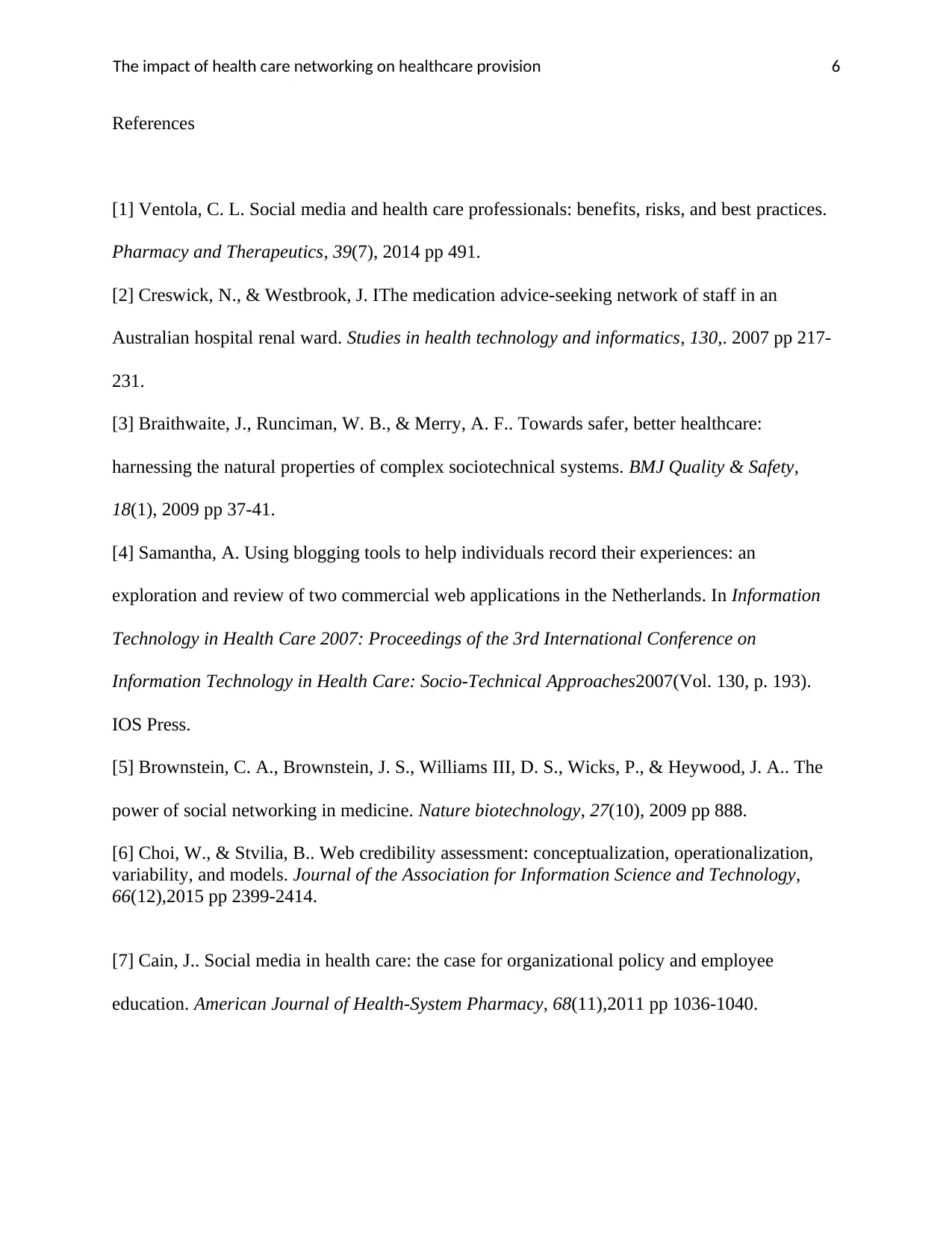
The impact of health care networking on healthcare provision 6
References
[1] Ventola, C. L. Social media and health care professionals: benefits, risks, and best practices.
Pharmacy and Therapeutics, 39(7), 2014 pp 491.
[2] Creswick, N., & Westbrook, J. IThe medication advice-seeking network of staff in an
Australian hospital renal ward. Studies in health technology and informatics, 130,. 2007 pp 217-
231.
[3] Braithwaite, J., Runciman, W. B., & Merry, A. F.. Towards safer, better healthcare:
harnessing the natural properties of complex sociotechnical systems. BMJ Quality & Safety,
18(1), 2009 pp 37-41.
[4] Samantha, A. Using blogging tools to help individuals record their experiences: an
exploration and review of two commercial web applications in the Netherlands. In Information
Technology in Health Care 2007: Proceedings of the 3rd International Conference on
Information Technology in Health Care: Socio-Technical Approaches2007(Vol. 130, p. 193).
IOS Press.
[5] Brownstein, C. A., Brownstein, J. S., Williams III, D. S., Wicks, P., & Heywood, J. A.. The
power of social networking in medicine. Nature biotechnology, 27(10), 2009 pp 888.
[6] Choi, W., & Stvilia, B.. Web credibility assessment: conceptualization, operationalization,
variability, and models. Journal of the Association for Information Science and Technology,
66(12),2015 pp 2399-2414.
[7] Cain, J.. Social media in health care: the case for organizational policy and employee
education. American Journal of Health-System Pharmacy, 68(11),2011 pp 1036-1040.
References
[1] Ventola, C. L. Social media and health care professionals: benefits, risks, and best practices.
Pharmacy and Therapeutics, 39(7), 2014 pp 491.
[2] Creswick, N., & Westbrook, J. IThe medication advice-seeking network of staff in an
Australian hospital renal ward. Studies in health technology and informatics, 130,. 2007 pp 217-
231.
[3] Braithwaite, J., Runciman, W. B., & Merry, A. F.. Towards safer, better healthcare:
harnessing the natural properties of complex sociotechnical systems. BMJ Quality & Safety,
18(1), 2009 pp 37-41.
[4] Samantha, A. Using blogging tools to help individuals record their experiences: an
exploration and review of two commercial web applications in the Netherlands. In Information
Technology in Health Care 2007: Proceedings of the 3rd International Conference on
Information Technology in Health Care: Socio-Technical Approaches2007(Vol. 130, p. 193).
IOS Press.
[5] Brownstein, C. A., Brownstein, J. S., Williams III, D. S., Wicks, P., & Heywood, J. A.. The
power of social networking in medicine. Nature biotechnology, 27(10), 2009 pp 888.
[6] Choi, W., & Stvilia, B.. Web credibility assessment: conceptualization, operationalization,
variability, and models. Journal of the Association for Information Science and Technology,
66(12),2015 pp 2399-2414.
[7] Cain, J.. Social media in health care: the case for organizational policy and employee
education. American Journal of Health-System Pharmacy, 68(11),2011 pp 1036-1040.
⊘ This is a preview!⊘
Do you want full access?
Subscribe today to unlock all pages.

Trusted by 1+ million students worldwide
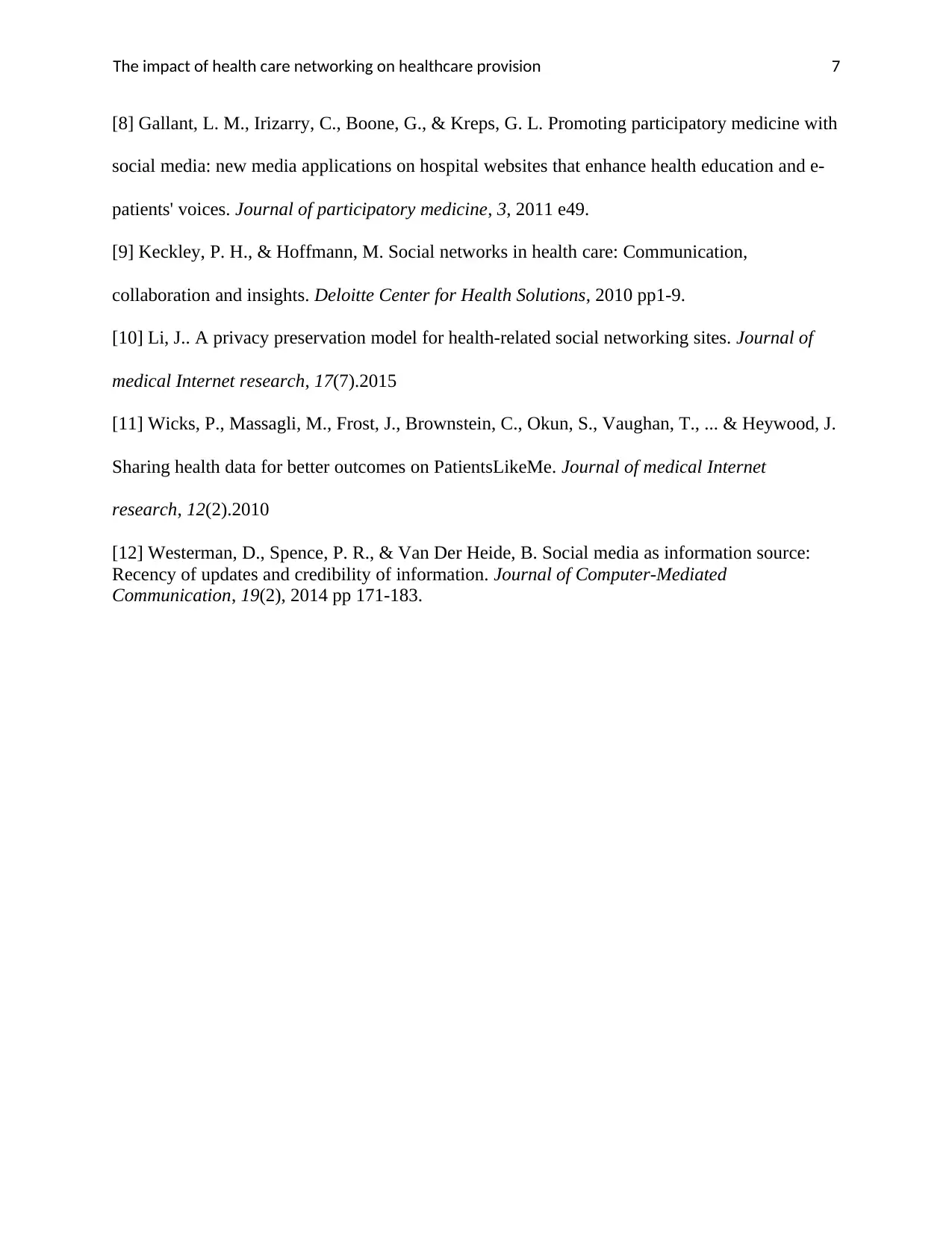
The impact of health care networking on healthcare provision 7
[8] Gallant, L. M., Irizarry, C., Boone, G., & Kreps, G. L. Promoting participatory medicine with
social media: new media applications on hospital websites that enhance health education and e-
patients' voices. Journal of participatory medicine, 3, 2011 e49.
[9] Keckley, P. H., & Hoffmann, M. Social networks in health care: Communication,
collaboration and insights. Deloitte Center for Health Solutions, 2010 pp1-9.
[10] Li, J.. A privacy preservation model for health-related social networking sites. Journal of
medical Internet research, 17(7).2015
[11] Wicks, P., Massagli, M., Frost, J., Brownstein, C., Okun, S., Vaughan, T., ... & Heywood, J.
Sharing health data for better outcomes on PatientsLikeMe. Journal of medical Internet
research, 12(2).2010
[12] Westerman, D., Spence, P. R., & Van Der Heide, B. Social media as information source:
Recency of updates and credibility of information. Journal of Computer-Mediated
Communication, 19(2), 2014 pp 171-183.
[8] Gallant, L. M., Irizarry, C., Boone, G., & Kreps, G. L. Promoting participatory medicine with
social media: new media applications on hospital websites that enhance health education and e-
patients' voices. Journal of participatory medicine, 3, 2011 e49.
[9] Keckley, P. H., & Hoffmann, M. Social networks in health care: Communication,
collaboration and insights. Deloitte Center for Health Solutions, 2010 pp1-9.
[10] Li, J.. A privacy preservation model for health-related social networking sites. Journal of
medical Internet research, 17(7).2015
[11] Wicks, P., Massagli, M., Frost, J., Brownstein, C., Okun, S., Vaughan, T., ... & Heywood, J.
Sharing health data for better outcomes on PatientsLikeMe. Journal of medical Internet
research, 12(2).2010
[12] Westerman, D., Spence, P. R., & Van Der Heide, B. Social media as information source:
Recency of updates and credibility of information. Journal of Computer-Mediated
Communication, 19(2), 2014 pp 171-183.
1 out of 7
Related Documents
Your All-in-One AI-Powered Toolkit for Academic Success.
+13062052269
info@desklib.com
Available 24*7 on WhatsApp / Email
![[object Object]](/_next/static/media/star-bottom.7253800d.svg)
Unlock your academic potential
Copyright © 2020–2025 A2Z Services. All Rights Reserved. Developed and managed by ZUCOL.




